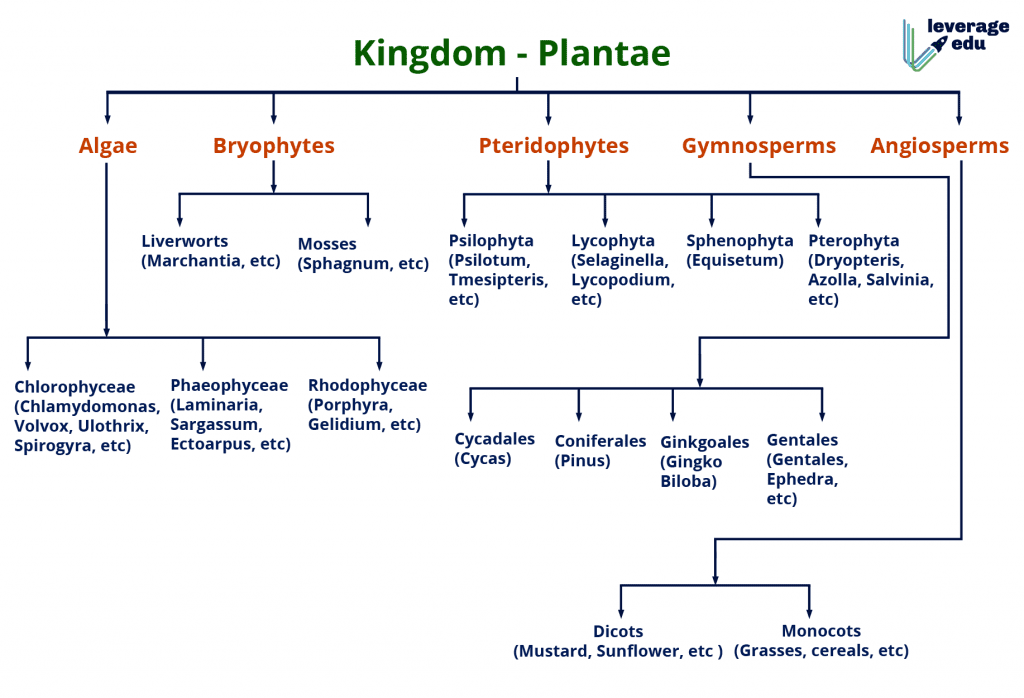One of the most interesting topics in NCERT Biology Class 11 is the Plant Kingdom. The chapter deals with the brief of the entire plant kingdom with examples and characteristics of each component. Studying this chapter on your own can be a little confusing as it requires proper flow charts and easy to remember points for better understanding. It also covers many interesting and major topics which are essential for the NEET examination. In this blog, we will be covering plant kingdom class 11 notes to make the learning process easier for you!
This Blog Includes:
Introduction to Plant Kingdom Class 11
Whittaker, in 1963, divided living organisms into five kingdoms and Kingdom Plantae. This chapter holds special importance in the board exams, and this blog will help you in grasping the concepts of the plant kingdom. In the following plant kingdom class 11 notes, you may or may not come across new points, but we suggest you focus on them and improvise wherever there is confusion.

Also Read: Class 11 Plant Growth and Development
Important Aspects Of A Plant Kingdom
The Plant Kingdom is defined as a multicellular, eukaryotic living organism where the cell wall contains chlorophyll, imparting green color to the plants. Broadly, the plant kingdom is divided into two classifications:
- Cryptogame: The plants without seeds
- Phanerogamae: The plants that bear seeds
Furthermore, it is divided into:
- Algae
- Bryophytes
- Pteridophytes
- Gymnosperms
- Angiosperms
Algae
They have a simple thallus-like body which has numerous commercial benefits. They are of three types: Red, Brown and Green Algae. Algae are sources of nutrition in some countries (Sargassum) and also a rich source of iodine (Fucus). Moving ahead with the plant kingdom class 11 notes, you will find the characteristics of algae:
- The body is unicellular, filamentous, or parenchymatous, colonial.
- Algaes do not have any vascular tissue
- The plant body belongs to thallus style
- Algae are usually found in aquatic areas, but a few of them are found in moist terrestrial habitats such as moist soil and wet rocks.
- They reproduce in the following ways:
- Vegetative fragmentation
- Asexually by zoospores
- Sexually by Isogamous or Oogamous or Anisogamous
Also Read: CBSE Class 11 Biology Syllabus
Bryophytes
They are also called as amphibians of the plant kingdom as they grow in moist and shady regions. They live on soil and require water for reproduction, just like the amphibians of the animal kingdom. The Characteristics of Bryophytes in plant kingdom is as follows:
- They majorly grow on rocks, walls, and damp soil.
- The body type is free-living and does not contain any roots.
- They reproduce by following methods:
- Vegetative reproduction by tubers, buds, and fragmentation
- Asexual reproduction is through gammae, a specialized reproduction structure.
- Sexual reproduction is between males (antheridium) and females (archegonium).
Must Read – Mineral Nutrition Class 11
Pteridophytes

These are vascular plants with differentiated parts like roots, leaves, and stems. They are further classified into Psilopsida, Lycopsida, Sphenopsida, Filicopsida. Characteristics of Pteridophytes:
- They contain the vascular system. However, companion cells, xylem vessels, and sieve tubes are absent.
- They have leaf-like appendages that extend the sporangia of the plant. These appendages are called sporophylls.
- They reproduce by the following methods:
- The mother cells undergo meiosis to produce spores, which germinates to produce thallus.
- Sexual reproduction in water conditions, where male organs called antheridia and female organs called archegonia fertilizes
Gymnosperms
[optin-monster-shortcode id=”xf2mlnjiouddzrshykdb”]They have a wooden structure that forms bushes or trees in large (Sequoia sempervirens) and small (Zamia pygmaea). The plant body belongs to the prototype and is well-differentiated into the stem, roots, and leaves. The next part in plant kingdom class 11 notes is the Characteristics of Gymnosperms:
- They have branched stems (Pinus) and unbranched (Cycas). Their roots are generally tapping roots and, in some genera, have mycorrhiza, a form of fungal association (Pinus), while some have specialized roots (Cycas), and a few have nitrogen-fixing bacterial roots called coralloid roots.
- The leaves are simple or compound. The Cycas have pinnate leaves for a few years, while in Conifers, the leaves have a needle-like structure with reduced surface area. The leaves are well-developed and adapt to varying climatic conditions. The leaves have a sunken stoma, which reduces water loss from the surface of the leaves.
- The ovary is not enclosed inside the ovary wall and is always exposed.
- They reproduce by following methods:
- Produces haploid microspore and megaspore
- The male and female do not have an independent existence.
- The transfer of pollens (pollination) is via air, and the zygote develops into embryos. The embryos then develop into naked seeds.
Also Read: Class 11 Anatomy of Flowering Plants
Angiosperms
The plants have flowers, where the male and female organs are developed into separate structures, and pollination occurs through air or insects. The seeds produced are developed into fruits. Thus, the seeds are enclosed after the fertilization process. Characteristics of Angiosperms:
- The size of an angiosperm varies from 0.1cm to more than 100m.
- Angiosperms are further classified into monocots and dicots.
- The reproduction takes place by the following methods:
- Sexually between pollen grains (male parts) and ovules (female part). The pollens are present in the flower’s stamen while the female organ is situated in the carpel. The ovule contains embryo sacs where Fertilization takes place.
- Double Fertilization is another way through which one male gamete fuses with another egg to form an embryo. This process is called Syngamy. In triple fusion, the other male gamete fuses with two polar nuclei to form an embryo or endosperm. As you see, Fertilization takes place twice in this process, hence the name.
- Double Fertilization is another way through which one male gamete fuses with another egg to form an embryo. This process is called Syngamy. In triple fusion, the other male gamete fuses with two polar nuclei to form an embryo or endosperm. As you see, Fertilization takes place twice in this process, thus the name!
Monocotyledons (Examples: White rice, Bananas)
- It contains a single cot.
- Has Fibrous Root System
- Contains a large number of vascular bundles
- It has parallel venation.
Dicotyledons (Examples: Mango, Apple)
- It contains two cots.
- Has Tap Root Systems
- Contains a relatively lesser number of vascular bundles
- It has a reticulate venation.
This is the entire gist of plant kingdom class 11 notes, where you have learned about the different classification of the plant kingdom and all the characteristics of plant cells. If you are confused about which career to choose after completing your schooling, then take help from the Leverage Edu experts and find a perfect career pathway for yourself!
-
Very helpfull to revise the lesson easily..😊
-
Awesome thank you so much 🌸❤️🙏🏻

 One app for all your study abroad needs
One app for all your study abroad needs





















 45,000+ students realised their study abroad dream with us. Take the first step today.
45,000+ students realised their study abroad dream with us. Take the first step today.


2 comments
Very helpfull to revise the lesson easily..😊
Awesome thank you so much 🌸❤️🙏🏻